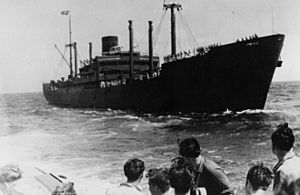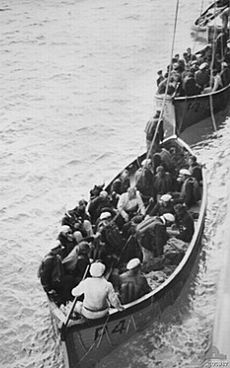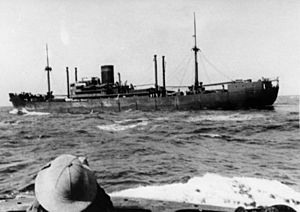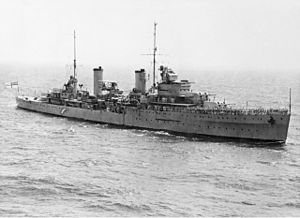German auxiliary cruiser Kormoran facts for kids

Auxiliary cruiser Kormoran meets a German U-boat at sea
|
|
Quick facts for kids History |
|
|---|---|
| Name | Steiermark |
| Operator | Hamburg America Line |
| Route | East Asia (intended) |
| Builder | Friedrich Krupp Germaniawerft, Kiel, Germany |
| Launched | 15 September 1938 |
| Fate | Requisitioned by Kriegsmarine |
| History | |
| Name | Kormoran |
| Namesake | SMS Cormoran and the Cormorant |
| Commissioned | 9 October 1940 |
| Reclassified | Auxiliary cruiser (1940-41) |
| Identification |
|
| Fate | Scuttled following battle, 19 November 1941 |
| General characteristics as Kormoran | |
| Type | Handelsstörkreuzer (commerce raider) |
| Tonnage | 8,736 GRT |
| Length | 164 m (538 ft 1 in) |
| Beam | 20.20 m (66 ft 3 in) |
| Draught | 8.50 m (27 ft 11 in) |
| Propulsion | 4 × 9-cylinder diesel motors |
| Speed | 18 knots (33 km/h; 21 mph) |
| Boats & landing craft carried |
1 × LS-3 minelaying boat |
| Complement | 25 officers, 375 enlisted |
| Armament |
|
| Aircraft carried | 2 × Arado 196 seaplanes |
The German ship Kormoran (HSK-8) was a special kind of warship called an auxiliary cruiser or "merchant raider" during World War II. It was part of the Kriegsmarine (German navy).
Before the war, Kormoran was a regular merchant ship named Steiermark. The navy took it over and changed it into a raider. The Germans called it Schiff 41, and the Allied navies knew it as "Raider G." Kormoran was the largest merchant raider Germany used in World War II. During its year-long journey in the Atlantic and Indian oceans, it sank 10 merchant ships and captured one more.
Kormoran is also famous for a battle with the Australian light cruiser HMAS Sydney. This battle happened off Western Australia on 19 November 1941. Both ships were badly damaged and sank. Most of Kormoran's crew (318 out of 399) were rescued and became prisoners of war. However, all 645 people on the Australian cruiser Sydney were lost.
The wreck of Kormoran was found on 12 March 2008. The wreck of Sydney was found five days later. The battle was very close, and Kormoran had the advantage of surprise. For many years, people wondered why Sydney was lost with everyone on board, while most of the German crew survived. This led to many discussions and even some untrue stories.
Contents
Building and Changing the Ship
The ship Steiermark was built by Friedrich Krupp Germaniawerft in Kiel, Germany. It was made for the Hamburg-Amerika Line to travel to East Asia. It was launched in 1938, but the war started before it could begin its regular trips.
After World War I, Germany's navy was limited by the Treaty of Versailles. Later, in 1935, the Anglo-German Naval Agreement eased some of these rules. By the 1930s, Germany knew its navy was smaller than other countries'. So, they decided that auxiliary cruisers, which could attack enemy trade ships, would be important in future wars. They found merchant ships that could be turned into raiders if war broke out.
Steiermark was one of these ships. It was called Schiff 41 by the navy. Work to change it into a warship began in early 1940. This work was very important, second only to building U-boats. The changes included adding hidden weapons and building living areas for the sailors. They also made special rooms for prisoners. The ship was given equipment to change its look, so it could pretend to be other merchant ships. While the ship was being refitted, its future crew trained on another ship.
In July 1940, Theodor Detmers was chosen to command Schiff 41. He was 37 years old, the youngest person to command a German merchant raider. Detmers named the ship Kormoran. He was inspired by an old German raider called SMS Cormoran and the cormorant bird. He thought the bird's way of catching fish was like his ship's job of catching Allied vessels. After successful tests in September 1940, Kormoran officially joined the navy on 9 October.
Ship Design and Features
Kormoran was one of nine civilian ships that the German Navy changed into merchant raiders. These ships were also called Hilfskreuzer (auxiliary cruisers) or Handelsstörkreuzer (trade disruption cruisers). Kormoran was the biggest and newest of these raiders when it was converted.
After its changes, Kormoran was 164 metres (538 ft 1 in) long and 20.20 metres (66 ft 3 in) wide. It weighed 8,736 tons. It had four diesel engines that powered electric motors, allowing the ship to travel at 18 knots (33 km/h; 21 mph).
The raider had six main guns, called 15-centimetre (5.9 in) SK L/45 guns. These guns were from World War I. Four of them were hidden behind fake hull plates, and two were hidden by fake cargo walls.
It also had five 2-centimetre (0.79 in) anti-aircraft guns to shoot down planes. These guns were hidden and could be raised using hydraulic platforms. There were also two 3.7-centimetre (1.5 in) anti-tank guns, hidden by metal panels. Kormoran had six torpedo tubes: two on the upper deck and two underwater on each side. It also carried mines and a small boat for laying them.
The raider carried two Arado Ar 196 seaplanes for scouting. These planes were stored inside a cargo hatch. They were launched and recovered from the water using hoists. Because of mechanical problems and other issues, the planes were only used seven times during the ship's missions.
Ship's Journey and Missions
Breaking Through the Blockade
After joining the navy, Kormoran went to Kiel to get supplies for a 12-month trip. Then it went to Gotenhafen (now Gdynia, Poland) for more tests of its weapons and equipment. Even with some problems, Captain Detmers decided to fix them at sea to avoid delays.
The raider left on 3 December. Once it was out of German waters on 10 December, it changed its disguise. It now looked like the Soviet freighter Vyacheslav Molotov. The Royal Navy had blockaded German waters. Kormoran had to get through this blockade to reach its patrol area. Detmers chose to sail north of Iceland and through the Denmark Strait. This route was longer but safer from British ships and planes. The raider passed through the strait on 12 December during a heavy storm. It entered the Atlantic Ocean without seeing any Allied ships.
Atlantic Ocean Attacks
Once in the Atlantic, Kormoran was ordered to find targets and then move to the Indian Ocean. It also had to lay mines near Allied ports in India or Australia. Kormoran was also supposed to resupply U-boats.
The raider's first area was in the Atlantic. For the first two weeks, it only saw ships from the United States, which was still neutral. German raiders were not allowed to attack neutral ships.
On 6 January 1941, Kormoran found the Greek freighter Antonis. The raider ordered the ship to stop. Antonis was carrying coal and had British machine guns. Even though Germany was not at war with Greece, the weapons and cargo meant Kormoran could sink it. The crew and weapons were moved to Kormoran, and the German crew sank Antonis.
On 18 January, Kormoran spotted a tanker. It was sailing without lights and zigzagging, so Detmers thought it was an Allied ship. Kormoran fired at the tanker to stop it. The tanker, named British Union, sent a distress call. Firing continued until the tanker caught fire. The crew abandoned ship. Kormoran had to use torpedoes and shells to sink the 6,987-ton tanker. The tanker's master, 27 sailors, and a pet monkey were rescued.
On 29 January, Kormoran found a large merchant ship. The raider dropped its camouflage and ordered the ship to stop. The ship did not obey, so Kormoran fired. The ship, the 11,900-ton Afric Star, was carrying meat and butter. It was too damaged to be captured. After taking important documents and rescuing 76 people, including two women, Kormoran sank it.
Later that day, Kormoran found another merchant ship. It opened fire and heavily damaged the ship, which caught fire. The ship was the 5,273-ton British freighter Eurylochus, carrying bombers. Kormoran sank it with a torpedo. 39 Chinese and four British crew were rescued. British warships tried to find Kormoran but failed.
Kormoran then met the supply ship Nordmark on 7 February. Kormoran transferred 170 prisoners to Nordmark. Four Chinese sailors from Eurylochus stayed on Kormoran as laundrymen.
On 22 March, Kormoran found another tanker, the British vessel Agnita. The tanker tried to send a distress signal, but Kormoran jammed it and opened fire. Agnita surrendered after two shots. 12 British and 25 Chinese sailors were captured. Kormoran sank the tanker.
Three days later, Kormoran found another tanker. This time, the 11,309-ton Canadian tanker Canadolite surrendered. It was captured and sent to France with a German crew. It was renamed Sudetenland and used until 1944.
On 9 April, Kormoran attacked the British freighter Craftsman. It was carrying an anti-submarine net. The ship was heavily damaged and caught fire. 46 survivors were rescued. Kormoran had to use a torpedo to sink it.
| Date | Name | Tons (GRT) | Nationality | Location |
|---|---|---|---|---|
| 13 January 1941 | Antonis | 3,729 | 18°17′N 28°32′W / 18.283°N 28.533°W | |
| 18 January 1941 | British Union | 6,987 | 26°29′N 31°07′W / 26.483°N 31.117°W | |
| 29 January 1941 | Afric Star | 11,900 | 8°44′N 24°38′W / 8.733°N 24.633°W | |
| 29 January 1941 | Eurylochus | 5,273 | 8°15′N 24°04′W / 8.250°N 24.067°W | |
| 22 March 1941 | Agnita | 3,552 | 3°20′S 23°40′W / 3.333°S 23.667°W | |
| 25 March 1941 | Canadolite | 11,309 | 2°30′N 23°48′W / 2.500°N 23.800°W (captured) | |
| 9 April 1941 | Craftsman | 8,022 | 0°32′N 23°37′W / 0.533°N 23.617°W | |
| 12 April 1941 | Nicolaos D. L. | 5,486 | 1°54′S 22°12′W / 1.900°S 22.200°W |
On 12 April, Kormoran found another ship, the Greek freighter Nicholas D.L.. It was carrying Canadian timber. The ship sent a distress signal, but Kormoran fired anyway. The ship's bridge was destroyed, and its crew abandoned ship. Because of its cargo, the ship was hard to sink. Kormoran left it to sink slowly.
On 19 April, Kormoran met another German raider, Atlantis, and a supply ship. They exchanged supplies and prisoners. Kormoran then changed its disguise to the Japanese freighter Sakito Maru and sailed into the Indian Ocean.
Indian Ocean Missions
In the Indian Ocean, Kormoran first refueled other German ships. Its mission area was expanded to cover the whole ocean. On 5 June, it changed its disguise again to the Japanese ship Kinka Maru. It patrolled around the Maldives without success.
On 24 June, near Madras, Kormoran was spotted by a ship that the Germans thought was a British auxiliary cruiser. Detmers decided to leave the area to avoid suspicion.
On 26 June, Kormoran found a darkened merchant ship. It opened fire, causing huge damage. Nine crew members from the Yugoslavian cargo ship Velebit were rescued. The ship was left to sink. That same afternoon, Kormoran spotted another ship. It closed in and revealed its identity. The ship, the 3,472-ton Australian vessel Mareeba, sent a distress call. Kormoran fired, destroying its wireless room and engine room. 48 sailors were rescued. The Australian ship was too damaged to save and was scuttled.
After this, Kormoran did engine repairs. A sailor was accidentally killed by electricity while working on a seaplane. Kormoran then changed its disguise to the Dutch freighter Straat Malakka.
On 23 September, Kormoran found a ship at night. It identified itself as the Greek freighter Stamatios G. Embiricus. The raider shone searchlights on it and ordered it to stop. The Greek crew thought it was a British warship. When armed Germans boarded, they realized it was a raider. The ship was captured but was coal-fueled and didn't have enough fuel to go anywhere but its planned port. So, it was scuttled.
| Date | Name | Tons (GRT) | Nationality | Location |
|---|---|---|---|---|
| 26 June 1941 | Velebit | 4,153 | ||
| 26 June 1941 | Mareeba | 3,472 | 8°15′N 88°06′E / 8.250°N 88.100°E | |
| 26 September 1941 | Stamatios G. Embirikos | 3,941 | 0°01′S 64°30′E / 0.017°S 64.500°E |
A few days later, Kormoran intercepted radio messages from the Norwegian tanker Thelma. This helped the Germans learn where the tanker was going. However, Kormoran did not find it.
On 16 October, Kormoran met the supply ship Kulmerland. Supplies were transferred to Kormoran, and its prisoners were moved to Kulmerland. After leaving on 24 October, Kormoran did more maintenance. It planned to sail up the coast of Western Australia. However, it detected radio signals from an Australian warship, HMAS Canberra. So, Detmers decided to sail further north.
The Final Battle and Sinking
Note: All times in this section are UTC+7.
On 19 November 1941, just before 4:00 PM, Kormoran was about 150 nautical miles (280 km; 170 mi) southwest of Carnarvon, Western Australia. It was sailing north. At 3:55 PM, the masts of a cruiser, HMAS Sydney, were spotted. Detmers ordered Kormoran to turn towards the sun and go as fast as possible. Sydney also spotted the German ship and sped up to intercept it.
As Sydney got closer, it sent signals with a searchlight. The Germans did not understand the first coded message. Sydney kept repeating for half an hour, then asked Kormoran to show its signal letters. Kormoran raised flags that said "PKQI," which was the callsign for its disguise, the Dutch merchant ship Straat Malakka. The flags were hard to see because of the raider's funnel. After Sydney asked for the flags to be made visible, the German crew did so. By 4:35 PM, Sydney was 8,000 metres (8,700 yd) away.
Around 5:00 PM, Detmers told his radio operators to send a distress signal. It said Straat Malakka was being approached by a suspicious ship. This message was partly received by a tugboat and a shore station. Sydney positioned itself next to Kormoran, about 1,300 metres (1,400 yd) away. Its main guns and torpedoes were aimed at the raider.
Fifteen minutes later, Sydney signaled, "Show your secret sign." Detmers knew he couldn't fool Sydney any longer. He ordered Kormoran to drop its disguise, raise the German battle flag, and start firing all weapons. Kormoran's first shots hit near Sydney. The next four shots hit Sydney's bridge, gun control tower, and front guns. Two torpedoes were also launched. Sydney could only fire one full set of shots before its front guns were knocked out. These shots hit Kormoran's funnel and radio room.
Kormoran's gunners then aimed at Sydney's waterline. Sydney fired back with its rear guns. One shot damaged Kormoran's engine room and started a fire. Around the time of the eighth or ninth German shot, one of Kormoran's torpedoes hit Sydney. This made a hole in its side and caused the ship to sink by the front. Sydney then turned sharply, possibly trying to ram Kormoran, but it passed by.
By 5:35 PM, Sydney was heading south, heavily damaged, on fire, and slowing down. Its main guns were destroyed. Kormoran kept firing as Sydney moved away. Sydney fired torpedoes, but they missed. After turning, Kormoran's engines failed completely due to battle damage. The raider was stuck in the water, while Sydney continued to limp south. Even though it was stopped, Kormoran kept firing. It fired its guns for the last time around 5:50 PM.
By the end of the half-hour battle, the ships were about 10,000 metres (11,000 yd) apart, both badly damaged and on fire. The fire-fighting systems on Kormoran were destroyed. Since the oil fire was getting close to the ammunition and mine storage, Detmers ordered everyone to abandon ship at 6:25 PM. All boats and rafts were launched by 9:00 PM. A small crew stayed behind to keep weapons ready and prepare to sink the ship. During this time, Sydney was seen moving south-southeast at low speed. It disappeared over the horizon, but the glow of the burning ship was seen until midnight.
Kormoran was abandoned and scuttled at midnight. It sank slowly until its mine storage exploded half an hour later. The German survivors were in five boats and two rafts. During the evacuation, a rubber raft with 60 wounded men sank. In total, six officers, 75 German sailors, and one Chinese sailor from Kormoran were killed.
Rescue Efforts

The first raft of German survivors was found by the troopship Aquitania on 23 November. The ship's captain kept quiet for three days, fearing another raider was nearby.
The search for Sydney began on 23 November, as it was late returning to port. On 24 November, after the British tanker Trocas found a second Kormoran raft, a full search began. Several German lifeboats were spotted from the air on 25 November. Two groups of Germans who had reached shore were captured.
The passenger ship Koolinda rescued a lifeboat with 31 men on 26 November. The hospital ship Centaur found Detmers' lifeboat that night and towed it. The German lifeboat was damaged, so the survivors were moved to Centaur's lifeboats. On 27 November, the Germans were taken to Carnarvon and then to Centaur's cargo hold.
The last boat, with 70 Germans and two Chinese, was found by HMAS Yandra on 27 November. The search ended on 29 November. All of Kormoran's lifeboats were found. 318 of Kormoran's 399 crew members survived. Sadly, none of Sydney's 645 crew members were found. Only a damaged life raft and a lifebelt from Sydney were ever recovered.
What Happened Next
In Germany, information about the battle was put together from radio messages and news articles. It was published in 1943. A Kormoran crew member, who was sent home in a prisoner exchange, confirmed the details.
Most of the German survivors were taken to Fremantle, Australia, and questioned. The German officers told their sailors to give false answers to confuse the enemy. Despite this, Australian officials were able to figure out the main details of the battle.
The sailors were first held at Harvey, and the officers at Swanbourne Barracks. Later, they were all moved to prisoner-of-war camps near Murchison, Victoria. One sailor died in captivity in 1942. In 1945, Detmers and 19 other officers escaped through a tunnel, but they were all caught within days. Detmers was found with a dictionary that had secret battle reports hidden inside.
The German officers and sailors were sent back home after the war in 1947. When they arrived in Germany, they were searched. No new information about the battle was found.
Finding the Wrecks
Even though the approximate last position of Kormoran was known, finding the wrecks of Kormoran and Sydney was hard. The search area was very large. Some Australians also believed the Germans had lied about the location.
Several searches were done by the Australian military after the war, mainly to find Sydney. In 1990, Robert Ballard, a famous shipwreck explorer, was asked to lead a search. He agreed if the search area could be made much smaller. A meeting in 1991 didn't help narrow it down, so Ballard withdrew his offer.
David Mearns, an American shipwreck hunter, learned about the battle in 1996. He started studying it in 2001. With help from historians, Mearns found old documents and diaries from Kormoran crew members. These documents made him believe the German accounts were true. The Australian government gave money for the search.
Mearns planned to find Kormoran first. He calculated a "search box" by figuring out where the two rafts from the raider might have started from. This box was 52 by 34 nautical miles (96 by 63 km; 60 by 39 mi) in size. A ship called SV Geosounder would use a special sonar to scan this area. Mearns believed finding Kormoran would help narrow down the search for Sydney.
After some problems with equipment and weather, Geosounder began the search. It found Kormoran on 12 March 2008. The wreck was 2,560 metres (8,400 ft) deep. It was in two large pieces, with debris spread out between them. The location was 26°05′46″S 111°04′33″E / 26.09611°S 111.07583°E. The discovery was announced by the Australian Prime Minister on 17 March.
Mearns then used Kormoran's location to find Sydney. Sydney was found on 17 March at 26°14′31″S 111°12′48″E / 26.24194°S 111.21333°E, about 11.4 nautical miles (21.1 km; 13.1 mi) southeast of Kormoran. Both wrecks are now protected under Australian law. It is illegal to disturb them. They were added to the Australian National Heritage List on 14 March 2011.
After finding the wrecks, Geosounder returned to sea with a remotely operated vehicle (ROV). This ROV took photos and videos of the wrecks. Sydney was filmed from 3–6 April. The Kormoran wreck showed that the mine explosion had torn the back half of the ship apart. The search was finished on 7 April.
Awards and Legacy
For sinking Sydney, Captain Detmers received a higher award, the Knight's Cross of the Iron Cross. Other officers and a sailor from Kormoran also received the Iron Cross First Class. The rest of the crew received the Iron Cross Second Class.
The names of those killed on Kormoran are on the Laboe Naval Memorial in Germany. The name Kormoran was later given to another German ship. This was the German fast attack craft Kormoran, a fast attack craft built in 1959. It served until 1976. East Germany also had a ship named Kormoran for a few years.
Images for kids
See also
 In Spanish: Kormoran (HSK 8) para niños
In Spanish: Kormoran (HSK 8) para niños







